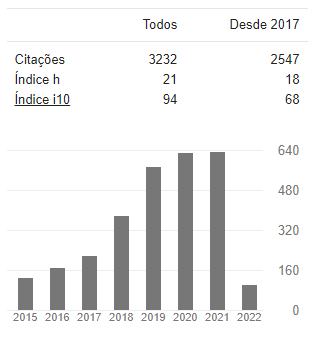Predição de Séries Temporais de parâmetros de Rede WCDMA – HSPA
DOI:
https://doi.org/10.15628/holos.2014.1908Resumo
Em telecomunicações, com o crescimento da demanda de tráfego de dados nas redes de terceira geração (3G), as operadoras de telefonia móvel têm atentado para o direcionamento dos recursos em infraestrutura nos locais onde se identifica maior necessidade. O direcionamento desses investimentos tem o objetivo de manter a qualidade do serviço prestado, principalmente, em regiões urbanas densas. Neste trabalho, é realizada a predição de séries temporais em redes HSPA – WCDMA dos parâmetros: potência recebida (Rx Power), potência de código do sinal recebido (Received Signal Code Power – RSCP), relação energia por chip em função da interferência (Energy per chip/Interference – Ec/Io) e taxa de transmissão (throughput) na camada física. A coleta dos valores dos parâmetros foi realizada numa rede em pleno funcionamento através de um drive test na cidade de Natal – RN. O modelo utilizado para predição das séries temporais foi o Modelo de Alisamento Exponencial de Holt. O objetivo das predições das séries temporais é verificar para quais parâmetros da rede HSPA – WCDMA o modelo de Holt melhor se adequou.Downloads
Referências
ARMSTRONG, J. S.; COLLOPY, F. Error Measures For Generalizing About Forecasting Methods: Empirical Comparisons. International Journal of Forecasting. v.8, p. 69-80, 1992.
BARROS, M., Processos Estocásticos, Papel Virtual, Rio de Janeiro 2004.
BIANCHI, L.; JARRETT, J. E.; HANUMARA, R. C. Forecasting incoming calls to telemarketing centers. The Journal of Business Forecasting Methods & Systems. v. 12, n. 2; p. 3-12, 1993.
BLOGH, J. S. and HANZO, L., Third Generation Systems and Intelligent Wireless Networking—Smart Antennas and Adaptive Modulation, John Willey & Sons, Chichester, 2002.
BOX, G. E. P., JENKINS, G. M., Time Series Analysis Forecasting and Control. Holden Day, California, 1976.
BOX, G. E. P., JENKINS, G. M. and REINSEL, G. C., Time Series Analysis Forecasting and Control. Prentice Hall, New Jersey, 1994.
CHATFIELD, C., Time-series forecasting, Chapmam & Hall/CRC, Boca Raton, 2000.
CUI, T., et. al., First Order Adaptive IIR Filter for CQI Prediction in HSDPA, 2010, IEEE Transactions on Education, 1-5, 18-21.
FADER, P. S.; HARDIE, B. G. S.; ZEITHAMMER, R. Forecasting new product trial in a controlled test market environment. Journal of Forecasting. v. 22, 2003, p. 391-410.
HYNDMAN, R. J.; KOEHLER, A. B. Another Look at Measures of Forecast Accuracy. International Journal of Forecasting. v.22, p. 679-688, 2006.
KAARANEN, Heikki et al., UMTS NETWORKS: Architecture, Mobility and Services, John Wiley & Sons Ltd, Inc., West Sussex, 2005.
KLOCKAR, L., SIMONSSON, A., GUNNARSSON, F., & Borg, A., ‘Channel Characterization and HSDPA Bit Rate Prediction of a Dense City Network’, 2009, IEEE Transactions on Education, 1-5, 26-29.
MAKRIDAKIS, S.; WHEELRIGHT, S. C.; HYNDMAN, R. J. Forecasting - Methods and Applications. New York: John Wiley, 1998.
MONTGOMERY, D. C., JERNNINGS, C., L and KULAHCI, M., Introduction to Time Series Analysis and Forecasting, John Wiley & Sons, New Jersey, 2008.
MORETTIN, P. A, TOLOI C. M. C., Modelos para Previsão de Séries Temporais, Instituto de Matemática Pura e Aplicada, Rio de Janeiro, 1981.
NOKIA (2003), HSDPA Solution, Nokia Group, Finland. *http://www.itu.int/ITU-D/tech/NGN/Manual/ManualAddReferences/A_3_2_3.pdf
SALLENT, O., et. al., A roadmap from UMTS optimization to LTE self-optimization, IEEE Transactions on Education, 49 (6), 172-182, 2011.
TOUHEED, H., QUDDUS, A.U. and TAFAZOLLI, R., Predictive CQI reporting for HSDPA, (2008). IEEE Transactions on Education 1-5, 15-18.
ZHENG, Y., et. al., A modified ARIMA model for CQI prediction in LTE-based mobile satellite communications, 2012, IEEE Transactions on Education, 822-826, 23-25.
WEI, W. W. S., Time Series Analysis – Univariate and Multivariate Methods, Pearson Education, Boston, 2006.
WRIGHT, G.; LAWRENCE, M.; COLLOPY, F. The Role of validity of Judgement in Forecasting. International Journal of Forecasting. v. 12, n. 1, p. 1-8, 1996.









































